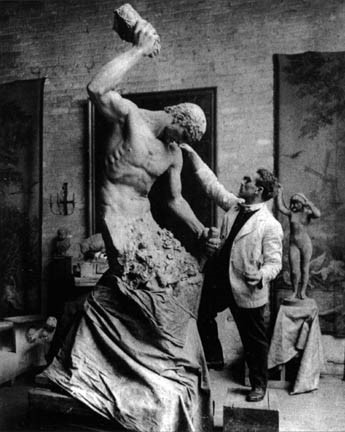Albin Polasek
Sculptor

1879 - 1965
Inducted in 2004
Biography
Regarded as one of the foremost American sculptors of the 20th Century, Czech-born Albin Polasek served nearly 30 years as head of the sculpture department for the Art Institute of Chicago before retiring to Winter Park, Florida in 1949. Polasek spent the last years of his life at a home and studio he designed and built at age 70 on Winter Park's Lake Osceola, where despite a debilitating stroke, he completed 18 major works before dying in 1965 at age 86.
Polasek was born in 1879 in Frenstat, Moravia, now part of the Czech Republic. After serving as an apprentice woodcarver, at age 22 he immigrated to the U.S., following his two brothers, both priests, to Minnesota. In 1905, he moved to Philadelphia for formal art training at the Pennsylvania Academy of the Fine Arts, where he studied under Charles Grafly, Jr., a renowned art educator and sculptor. As a student, in 1907 he created Man Carving His Own Destiny, an homage to his personal struggle to establish himself in the world. The sculpture became one of the most famous pieces (of more than 400) Polasek would create in his prolific career.
Before leaving the academy, Polasek became a naturalized American citizen. In 1910, his sculpture Faith, Hope and Charity won Polasek the prestigious Prix de Rome competition, an honor giving him entre to the Italian art world. For three years in Rome, he trained at the American Academy of Art. In 1911, he created what would become one of his most famous (and controversial) works, The Sower, a classical study of the human form. The bronze sculpture, which depicts a nude male sowing seeds, won honorable mention in the spring Paris Salon in 1913. Back in the states, the statue created a public stir when the Chicago Institute of Art chose to put it on public display outside the building. The piece was moved inside, and eventually found a permanent home in the Chicago Botanical Garden.
In 1916, the Chicago Institute of Art invited Polasek to join its faculty as head of its sculpture department. He remained in the post for 27 years, gaining a national reputation as "the Chicago artist" for creating landmark sculptures for buildings and green spaces throughout the Windy City. On the eve of his retirement in 1943, Polasek finished another iconic piece, Mother Crying Over the World, a lament on the danger facing the world's children at the outbreak of World War II.
Within months of his arrival in Florida in January 1950, Polasek suffered a stroke that left him paralyzed on his left side. Confined to a wheelchair the rest of his life, he adapted and learned to paint, draw and (with assistance) sculpt clay with his right hand. Later that same year he married, at age 70, for the first time. Before her untimely death only 18 months later, Ruth Sherwood–a close friend for many years and a former student–helped her husband organize their 3-acre property on Lake Osceola into a comfortable home and workplace.
In 1961, Polasek married Emily Muska Kubat. The couple set up the Albin Polasek Foundation and transformed the Polasek's home into the Albin Polasek Museum and Sculpture Gardens, which remains one of Florida's most popular cultural attractions. Before his death in 1965 at age 86, Polasek completed 18 major works at his Winter Park studio, including Victory of Moral Law. A political commentary on the Hungarian Revolution, the bronze sculpture won worldwide acclaim in 1957.
Related Links
- The Polasek Museum and Sculpture Gardens - http://www.polasek.org/

